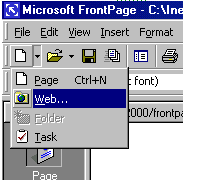Check the Background picture box and select an image by clicking the Browse... button to add a repeating graphic to the background of the page.
Enable hyperlink rollover effects adds a Cascading Style Sheet to the page that causes the appearance of text links to change when the mouse is placed over them. These effects are not visible in Netscape version 4 and lower.
Set the Background color and a default Text color if it is not black.
Hyperlink colors can be changed as well. The color set for Hyperlink will be the color of the text of a link that has not been viewed yet by the web site user. Visited hyperlink is the color the link will turn after the page has been visited. Active hyperlink is the color of the link as it is being pressed. This color is usually barely seen as the user quickly clicks the link. The default colors that web users are used to are blue for normal and purple for visited. Refrain from swapping these colors so users will not be confused!- Margins - Set the top and left margin width by pixels if necessary. It is not necessary to alter any of the properties on the remaining tabs.
Monday, September 26, 2011
Page Properties 2. Background,margins
Labels:
Web Development
Tuesday, September 20, 2011
Page Properties 1. general
Change various page properties by selecting File|Properties from the menu bar. The Page Properties window will allow you to change many general properties, the page background, margins, and more.
- General - Under the General tab, one property that needs to be changed is the Title. This is the text that will appear across the top of the screen above the browser's menu bar when the page is viewed on the web. Background sounds are not recommended and design-time control scripting options do not need to be changed.
Labels:
Web Development
Tuesday, September 13, 2011
Report View
When your web is completed, click Reports view to verify that links are correct and use the Reporting toolbar to switch between reports.
Open A Web
To open a web you have already created, select File|Open Web... from the menu bar. Select the web folder from the list and click Open.
Saving A Web
Save all the pages within the web created by FrontPage. These pages, however, are not visible to anyone on the Internet. You must copy the entire web folder to a network drive.
Labels:
Web Development
Friday, September 9, 2011
Creating a Web Page from a Template
FrontPage provides many individual page templates that can be added to any web. Follow these steps to add a template to a web page.
- Select File|New|Page... and choose a template.
- Select a template and click OK.
- Replace the place-holding body text with your own text and photos with images you would like on your web page.
Labels:
Web Development
Monday, September 5, 2011
Creating a Web Using the Web Wizard
- Select the type of web you want to create. It is usually best to create a simple One Page Web which you can add additional blank pages to as you need them. Enter a location for the web in the box provided beginning with "http://". This is the location where you can preview the web on your computer. It will need to be copied to the server to be viewed to the world on the WWW.
- Click OK and wait for FrontPage to finish creating the web.
- Now, explore your web. Click Folders view to see the initial page (default.htm) that was created and two folders. The "images" folder is where you will place all your graphics and photos. While it is not imperative that the images be placed in a separate folder, it keeps the web organized.
- Click on Reports view to see a list of reports for the site. As you construct your web, this page will be much more useful. From here, you can identify and correct broken hyperlinks and fix large pages that take a long time to load.
- View the navigation layout of the web by clicking Navigation view. Right now, there is only one page - the home page - listed. As more pages are added, this page becomes helpful to see how all your pages are linked together.
- Hyperlinks view allows you to manage the links on your pages.
- Optional - in Tasks view, list the tasks that need to be accomplished to create the web. Select Edit|Task|Add Tasks to add a task. Or click the down arrow beside the New button on the standard toolbar.
- Make pages and save them, marking them as completed in the task view.
- Click Folders view to locate the open the next page to work on.
- When you are ready to publish your web on the FGCU server, copy the folder to the server.
Labels:
Web Development
Subscribe to:
Comments (Atom)




